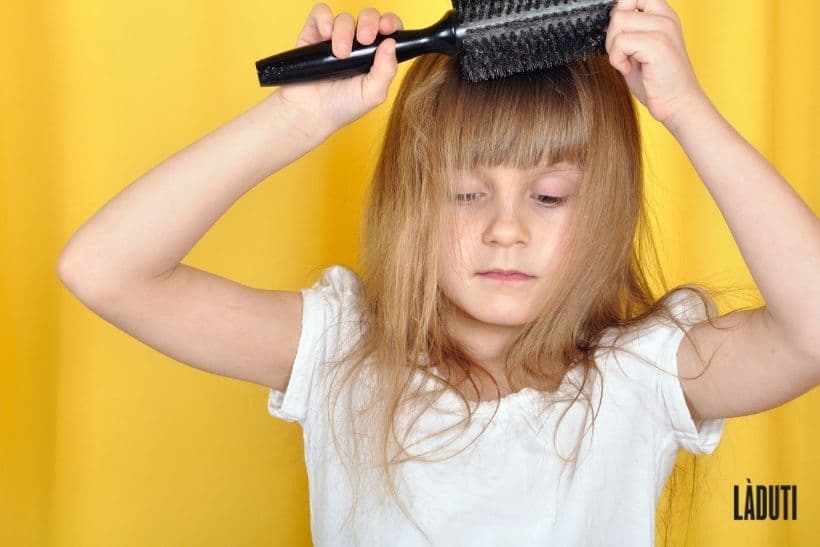Hair loss (Alopecia) in adults is not uncommon, and even in the twenties it is common to varying degrees in both women and men. Almost no one associates hair loss with children, and if they do, it is usually with chemotherapy. Even the youngest children are not spared the hair problem: endocrinological (hormonal and metabolic diseases), metabolic (Thyroid DiseasesDiabetes) as well as genetic disorders can be underlying factors that are often difficult to diagnose. However, early diagnosis is important for normal physical and mental development. In this blog post, you will learn what causes bald patches and light hair in adolescents and what you can do about it.
Features of hair loss in children
Hair structure and colour change fundamentally in the course of a person's life. Babies are often born with blond, curly hair and are suddenly brunette with straighter hair in adulthood. People are usually not spared from hair problems either. A basic distinction is made between diffuse Hair loss and bald patches. Diffuse in this context means the even loss of the hair on the head and the fullness of the hair. We speak of circumscribed or generalised hair loss. Genetically caused alopecia affects both forms of hair loss with the most varied manifestations.
Circumscribed hair loss
This form of hair loss can be both scarring and non-scarring. Non-scarring hair loss is subdivided into artificial alopecia such as fungal infections of the scalp (tinea capitis) or alopecia areata. The latter is manifested by sudden and episodic circular hair loss. Individual foci on areas of the scalp, eyelashes and eyebrows are grouped under the term Alopecia Areata Circumscripta. Alopecia Areata Totalis refers to the almost complete loss of body hair.
The most common manifestations of artificial alopecia are traction alopecia, trichotemnomania and trichotillomania. The latter refers to the compulsive pulling out of one's own head hair, which greatly reduces hair density. This psychological clinical picture mainly affects boys in childhood and female adolescents. Symptoms are broken hairs and bleeding without inflammation. We speak of trichotemnomania when the hair density has been artificially reduced, for example by cutting off the hair on the head by oneself. Psychological conflicts are usually the cause of the problem. Typical for traction alopecia are follicular inflammations and short as well as broken hairs with mostly scarring areas.
Infectious diseases are mostly caused by the spread of fungi on the skin, less frequently by viral infections or the inflammation of hair follicles. Tinea capitis is the most common fungal infection, which manifests itself in the form of scaly, reddened scalp lesions. In most cases, the pathogens are the fungal genera Trichophyton as well as Microsporum, which are transmitted in rural areas or by pets. Fungal infections can take a scarring course, as can blistering skin diseases (epidermolysis bullosa) or autoimmune diseases. Congenital skin defects, which are usually hereditary, can also leave atrophic scars in the area of the back of the head.
Generalized hair loss
Generalised hair loss takes the form of diffuse effluvium and is manifested by reduced hair density. Among other things, hair shaft anomalies are responsible for this form, which cause an increased fragility of the hair shaft. Genetic hair formation disorders (genotrichoses) can also occur in a prescribed form. Alopecia areata can also take a diffuse course. In particular, blond pre-teen girls between the ages of four and six suffer from loose anagen hair syndrome. The painlessly pull-out hair in the anagen phase (growth phase) is fine and lacklustre and most likely gets its defect from the defective differentiation of the hair root. Puberty helps to normalise the roots and anchor them firmly.
Especially in childhood, the immune system is not yet fully developed due to growth. In combination with an adequate vitamin and nutrient intake, the Laduti Hair Growth Serum help thin scalp hair to give more volume.
reasons for alopecia in the child
Your child combs his or her hair and you then pull it out of the brush in clumps? This is not a normal case and you should investigate the cause as quickly as possible, because in some cases a wide variety of diseases can also be the trigger for the loss of head hair. In any case, consult a specialist and have your child examined thoroughly.
Diseases of the scalp
A typical disease that appears in children of pre-pubertal age is the so-called tinea capitis or also Ringworm. The fungal disease is triggered by various pathogens and manifests itself in the form of scaly skin changes and bald patches on the scalp. Often these go with Inflammations accompanied and cause not only bald spots, but also hair breakage. Treatment is carried out with antimyotic, which is used to combat fungus.
If you notice such a condition in your child, act immediately, not only for the sake of your little one, but also to prevent a Infection to avoid. Fungal diseases are transmitted and other people should not come into contact with the affected parts of the body. Do not use shared combs or towels, nor bed linen and other textiles. Clean them thoroughly to prevent a relapse.
Circular hair loss
As the name already suggests, under circular hair loss round or oval bald spots on the head. In technical jargon is also called alopecia areata spoken, which is an autoimmune disease. The skin is uncharacteristically completely smooth. The reason for the unpleasant hair problem is a Dysfunction of the immune systemwhich sends false signals to the body, which in turn considers its own hair roots a danger. The reaction is their rejection, which weakens the roots and the head hair falls out.
This Inflammatory response can also heal spontaneously without treatment, but in some cases it can become a permanent condition and lead to hairless areas at regular intervals with varying shapes and characteristics. Often are Autoimmune diseases hereditaryOther triggers can be shock, StressThis can be caused by a poor diet, harmful medicines or a disturbed intestinal flora. Therefore, already in early childhood, pay attention to a a balanced diet and an adequate intake of nutrients. Strengthen both the immune system and the intestinal flora of your adolescent and avoid highly processed foods with a lot of sugar.
Traction hair loss
This refers to the loss of hair on the head as a result of excessive traction, for example due to a ponytail or braid that is tied too tightly. Traction alopecia can take a scarring and non-scarring course. In this case, we recommend wearing the adolescent's hair open or having it cut to create more volume. In this way, the hair can grow back in a relaxed manner and can be used again accordingly as a Braided hairstyle can be worn. However, remember not to style the hair too tight.
Nutrient deficiency
A balanced diet is the be-all and end-all, even in childhood. Vitamins and nutrients are essential to support the body in growth and regeneration. Hair quality is also fundamentally influenced by nutrient intake. Hair follicles need vitamin E as well as vitamin A to form the sebum (sebum) to cleanse the skin itself and keep the hair supple. Dramatically reduce foods high in sugar, avoid sodas as well as other sweet drinks, and avoid highly processed products and convenience foods. Above all fresh fruit and vegetables are beneficial for health and hair. Pay attention to the following nutrients in the diet of your child:
- vitamin A for cell renewal, anti-inflammation and blocking free radicals: especially yellow and green vegetables such as carrots, peppers and spinach, berries.
- vitamin B2 (Riboflavin)/Vitamin B3 for detoxification and metabolism: whole grain products, meat, fish, dairy products and peanuts.
- vitamin C to strengthen connective tissue and protect for free radicals is supplied by potatoes, citrus fruits, peppers, cabbage, tomatoes and spinach.
- Biotin (vitamin H or vitamin B7) for the formation of keratin, the main component of nails and hair, is found in eggs, oatmeal, soy, wheat germ, nuts and mushrooms, among others.
- Zinc is considered an important trace element that provides good hair and nail quality. Zinc suppliers are milk, cheese, poultry, beef and pork.
- omega-3 fatty acids provide the stability of the cell walls and keep the scalp hair and skin moist. Products such as walnuts, flaxseed and fish are particularly suitable for nutrient supply.
- Selenium serves as a protective barrier for oxidative stress and is mainly found in nuts, mushrooms as well as fish and meat.
- Silicon is responsible for the formation of keratin, as well as collagen, and thus hair density and elasticity. Suitable products are asparagus, barley, oats and potatoes.
Trichotillomania
Baldness can also psychosomatic reasons have: Anxiety, the loss of a loved one, tension due to starting school, a new sibling, bullying, the separation of parents. All this can lead to enormous stress and negatively affect the psyche of the child. The result can be tics like hair pulling, constant twirling of strands or even the scalp hair pulling be.
The child's psyche is not yet as solid as that of an adult. Meet this Pulse fault therefore with a lot of understanding and give your child a high level of attention. A pediatrician and Child Psychologist can also help you to get to the bottom of the causes of this obsessive-compulsive disorder. As soon as the problem is solved, your child will also get rid of these tics and the head hair can grow again undisturbed.
Conclusion
When the hair falls out in the little ones, the thought of cancer quickly emerges. But the loss of hair does not always have serious backgrounds. Nevertheless, always clarify any therapy with a doctor and start a treatment. no rash attempts at self-treatmentthat could cause additional harm to your child. Medications such as cortisone or homeopathic and natural medicine therapy without knowledge of the cause will worsen the hair problem rather than improve it. A Blood work gives you information about a possible nutrient deficiency, for example an insufficient iron supply, which can then be effectively combated.
Especially in the teenage years, often during the Puberty, appearance plays a big role for adolescents. Never meet your child with incomprehension if he plucks his own hair. The triggers are usually psychosomatic and could only exacerbate the problem. Pay attention to the Tips for a balanced diet and see a doctor to investigate the cause. Preventive can be the Laduti conditioning shampoo in combination with the Laduti Hair Growth Serum to more fullness and shine.
FAQ - Questions and answers
What are the causes of hair loss in children?
The triggers for alopecia in adolescents are varied. From genetic defects to circular hair loss, insufficient nutrient intake to psychosomatic diseases, it's all there. Be sure to clarify the cause with a doctor.
Which doctor can help with the hair problem of the affected children?
First consult a paediatrician. In most cases, he or she can already determine the trigger of the problem, for example a Iron deficiencyIf not, he or she will refer you to a specialist. If not, they will refer you to a specialist - usually a dermatologist or endocrinologist.
What can you do as a parent to reduce your child's suffering?
In the run-up to a medical examination, you can already positively influence the hair problem with a balanced diet. Hair loss in adolescents is often psychosomatic. Therefore, always be sensitive and patient.



